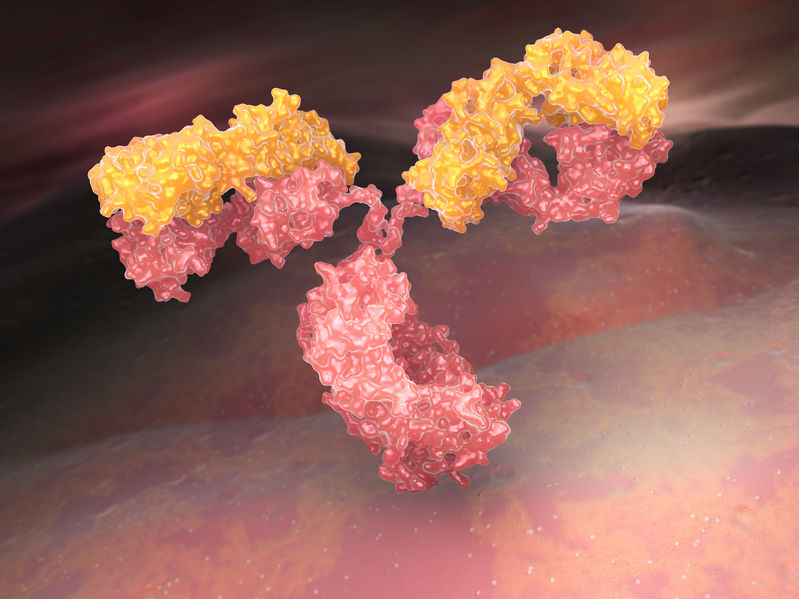 Aliyah Weinstein
Aliyah Weinstein
Antibody-dependent cellular cytotoxicity (ADCC) is a mechanism by which immune cells can kill target cells. Unlike phagocytes or T cells that directly kill their target cells, ADCC is mediated predominantly by NK cells—though other innate immune cells including monocytes, neutrophils, and eosinophils are also able to use this cytotoxic pathway—and requires the recognition by these cells of antibodies bound to the surface of the target cell. ADCC can occur naturally, but is most often thought of as a process that can be exploited in drug development. ADCC-dependent mechanisms of clearance have been observed in influenza, HIV, Ebola, malaria, and cancer.
Mechanism of NK cell-mediated ADCC
Antibodies—including therapeutic antibodies that are injected into patients as a treatment modality—bind to their target antigen on the surface of a cell. NK cells are subsequently able to recognize these antibody-bound cells using cell surface receptors, predominantly CD16. CD16 is an Fc receptor, specifically one that recognizes the Fc region of IgG antibodies. The binding of CD16 to IgG molecules triggers the release of granules containing perforin and granzyme from NK cells, which induce target cell apoptosis. This process can be controlled through interactions between NK cells and monocytes, which can inhibit ADCC through an inhibitory Fc receptor, CD32.
Naturally-occurring pathways to ADCC
Sustained immunity to Plasmodium, the parasite that causes malaria, is partially dependent on NK cell-mediated ADCC. ADCC controls acute malaria infection through direct lysis of infected red blood cells. This protection occurs naturally. Passive immunity to malaria can be transferred from person to person via immune serum, and this antibody-dependent immunity is also dependent on the presence of NK cells.
A similar pathway has been observed in immunity to HIV. ADCC is important for slowing the progression of HIV (and the animal model SIV) infection. While ADCC activity is increased in acute HIV infection, in chronic infection the expression of CD16 on the surface of NK cells is decreased, correlating with decreased ADCC. High ADCC was shown to correlate with increased long-term survival—independently of other markers of NK cell or immune function. It has also been proposed that ADCC may play a role in controlling secondary infections in HIV patients. Conversely, the dysregulation of ADCC in HIV-infected patients may lead to pathologic immune effects in these patients.
Therapeutic utilization of ADCC
A variety of immunotherapies take advantage of ADCC as the mechanism by which they induce the immune system to kill infected or diseased cells. This has particularly been true in treatments for Ebola, influenza, and cancer.
Both natural and therapeutic immunity to Ebola is dependent on IgG antibodies. Multiple therapeutic antibodies are currently being tested in animal models as well as for treating patients; however, their mechanisms of action are not well understood. It was recently described in a mouse model that while some of the antibodies may be neutralizing antibodies (i.e. able to directly inhibit target cells by binding to their cognate antigen), others function through the induction of ADCC. This has implications for future development of treatments for Ebola, as antibody-based therapies can be engineered to target either of these two mechanisms of clearance. Similar preclinical studies in influenza describe a broadly effective vaccine against influenza B dependent on ADCC as its mechanism of action.
Antibody-based therapies for cancer take advantage of ADCC as a mechanism of action as well. Tumors such as neuroblastoma, breast cancer, colorectal cancer, non-small cell lung cancer, head and neck cancer, and lymphoma can all be treated using various antibody-based therapies that function through ADCC. For example, Trastuzumab is a common treatment for breast cancer, as it targets HER2, which is overexpressed on up to 25 percent of breast cancers. This antibody mediates its effect partially by ADCC; interestingly, it may be effective not only against HER2-overexpressing breast cancers, but also against tumor cells on which HER2 is expressed at low levels, speaking to the sensitivity of this mechanism.
In conclusion
ADCC is a unique cytotoxic capability that bridges innate and adaptive immunity through its requirement for antibody deposition on target cells and the activity of NK cells, as well as monocytes, to mediate the cytotoxic effect. In addition to occurring naturally, it has been exploited as a therapeutic strategy across a variety of infectious and immunopathologic diseases. In the future, strategically designing therapeutic antibodies to preferentially bind activating Fc receptors such as CD16 will improve the efficacy of these treatments through an enhanced ability for ADCC.
Quartzy is the world’s No. 1 lab management platform. We help scientists easily organize orders, manage inventory, and save money. We’re free and always will be. Visit Quartzy.com or reach out at info@quartzy.com.
Interested in writing for The Q? Send us an email!
Share this:

Aliyah W.
Aliyah is a science communicator with a PhD in immunology, currently based in Boston. You can find her on Twitter @desabsurdites and on her blog at www.aliyahweinstein.com.
